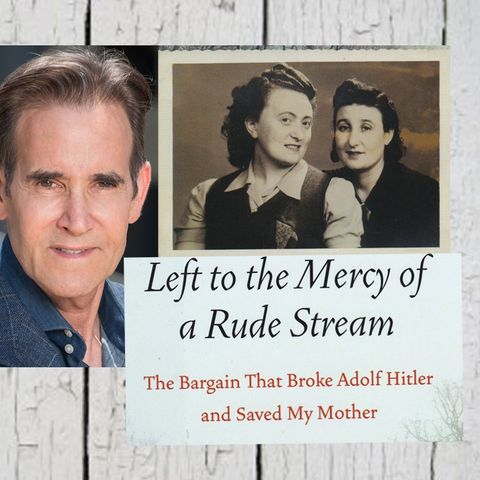Stan Goldman's book - Left to the Mercy of a Rude Stream.

Scarica e ascolta ovunque
Scarica i tuoi episodi preferiti e goditi l'ascolto, ovunque tu sia! Iscriviti o accedi ora per ascoltare offline.
Descrizione
I have interviewed over 100 celebrities. This next one is most important interview I have achieved. My subject is Stan Goldman who talks about his mother’s survival during the Holocaust....
mostra di piùSeven years after the death of his mother, Malka, Stanley A. Goldman traveled to Israel to visit her best friend during the Holocaust. The best friend's daughter showed Goldman a pamphlet she had acquired from the Israeli Holocaust Museum that documented activities of one man's negotiations with the Nazi's interior minister and SS head, Heinrich Himmler, for the release of the Jewish women from the concentration camp at Ravensbrück. While looking through the pamphlet, the two discovered a picture that could have been their mothers being released from the camp. Wanting to know the details of how they were saved, Goldman set out on a long and difficult path to unravel the mystery.
After years of researching the pamphlet, Goldman learned that a German Jew named Norbert Masur made a treacherous journey from the safety of Sweden back into the war zone in order to secure the release of the Jewish women imprisoned at the Ravensbrück concentration camp. Masur not only succeeded in his mission against all odds but he contributed to the downfall of the Nazi hierarchy itself. This amazing, little-known story uncovers a piece of history about the undermining of the Nazi regime, the women of the Holocaust, and the strained but loving relationship between a survivor and her son.
The son of a Holocaust survivor rehearses the horrors of his mother’s captivity, the improbability of her survival, and the deleterious lingering effects on her—and him.
Goldman (Loyola Law School, Los Angeles), the on-air legal editor for Fox News from 1996 to 2006, has several objectives here: to outline a piece of the history of the Holocaust (grim reminders of inhumanity appear on virtually every page), tell his mother’s remarkable story, ruminate about the perpetrators of the atrocities, and condemn those who profited by it, especially Alfried Krupp, whose family and wartime business found great success because of the Nazi war machine—and because of the labor of Jewish slaves. Although the author focuses primarily on his mother, he occasionally employs a wide-angle lens to show us what was going on throughout war-torn Europe; he even deals some with the stories of Anne Frank, Raoul Wallenberg, and other Holocaust icons. His mother’s story is astonishing; her survival, virtually impossible. As the war was winding down, she was working in the concentration camp at Ravensbrück and would almost certainly have died there if not for one man’s negotiation with Heinrich Himmler, who, seeing the end of the war (and realizing what would happen to him), made a deal to release some Jewish women, Goldman’s mother among them. She then traveled to Sweden, stayed about a year and a half and immigrated to America, where she married (the Nazis had shot her first husband) and gave birth to the author. Her dark memories never left her, and Goldman describes his own difficulties dealing with her as she aged and struggled. The author works hard to maintain a scholar’s tone in his text, but throughout, he also shows us the blood of millions seeping through his pages.
I knew well a little Jewish woman whose life was spared by a frightened Heinrich Himmler and the saving of her led to the death of Adolf Hitler. So begins the true account of an improbable April 1945 rescue from a Nazi death camp.
On April 21 a German Jewish businessman returned from the safety of neutral Sweden to the nation of his birth. He secretly met with Heinrich Himmler and arranged the release of a group of Jewish women (one of whom was my mother) from Ravensbruck. In exchange, Himmler's offer of a cease-fire on the Western front was delivered to the Allied leaders. The news of Himmler's attempt at a separate peace would be a principal cause of Hitler's April 30th suicide.
The book also documents the events allowing my mother to survive both the line to the gas chamber in Auschwitz and the allied bombings of Berlin where she toiled in slave labor. Interposed is how the Holocaust affected the remainder of her life as well as much of mine.
Informazioni
| Autore | Baby Boomers Talk Radio |
| Organizzazione | Baby Boomers Talk Radio |
| Sito | - |
| Tag |
-
|
Copyright 2024 - Spreaker Inc. an iHeartMedia Company

Commenti